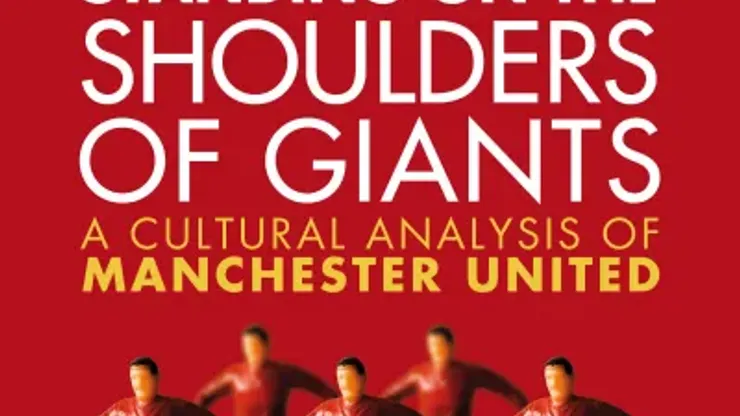The 2013/14 season is a period of intense transition for Manchester United, as former Everton manager David Moyes has become the first new manager of the team in more than 25 years.
Despite the recent adversity the team has suffered after defeats to Tottenham, Swansea and Sunderland, this is not the first time that the team has struggled or has faced transition in its history since 1878 as a recent book by author Søren Frank points out.
His book, Standing on the Shoulders of Giants, looks back across the entire history of Manchester United, from its very beginnings as Newton Heath LYR FC in 1878 through to the Red Devils of the 2012/13 season. It will be how the team adapts to the challenges it now faces that will decide more than Cup wins or Championships could. Will it reconnect to the past and the continuity of ideals that have supported the team throughout the years, the Manchester United ‘brand’, or run to the future in a different direction?
In his introduction, Mr. Frank set out what he sees as the four pillars of the Manchester United brand:
1. a free-flowing style of attacking football,
2. a philosophy that is a combination of rivalry and excellence exemplified through youth development,
3. the institution’s pop cultural associations, and
4. its self marketing as a transnational brand.
In the last chapter, he forms the questions now facing the team’s future. It is a book that he states is written with a pen in each hand, one hand writing as a fan, the other as an intellectual, combining throughout the three tracks of cultural history, aesthetic appreciation, and factual information. It is an ambitious goal, and even if it is in fact just a goal rather than a reality, the book is admirable in its scope and depth. Chapters are organized around the specific date of a Manchester United milestone, the history spreading out from it like that stone thrown into a pond. There is a good deal of back passing, changing time and perspective in these bites of history that come dangerously close to scoring against the book, but it is pulled off like Sir Alex Ferguson’s glance at his watch in the last 15 minutes of a match, so that the story moves ahead through years good and bad to the present.
If there is a problem with the book, it is something that seems trivial, but is actually important to being able to grasp the story fully; the typeface. The book is printed in a font that is a challenge, which is unusual in books from this press. One sentence that is spaced well is followed by another where all the words are run together. It is hard on the eye, and having to go back and reread paragraphs breaks the continuity of the prose, and the narrative suffers.
This aside, the author nicely introduces himself chronologically into the text in the chapter December 1978, with the first Manchester United game that he watched on television as a boy in Denmark. It is a personal look at where his own obsession with the team began, and through it he taps into the pillar of Manchester United’s transnational appeal.
The book also shines in its look at the Munich air disaster, what it meant to the team then and how that shattering event has shaped and been shaped by the club since 1958. Another chapter describing the financial dealings and control by the Edwards family gives a look into the club from another angle that brings a fullness to the team’s history. A further chapter examines how the commercial efforts of the club has created a schism between the traditional working class roots of the team and what is perceived as soulless corporate merchandising. It makes me think about the increasing number fans I see wearing Manchester United sweatshirts, hats and jerseys. This a book they should read to understand the team they support. Through it I, as an impartial observer as I wrote in a review of Sir Alex Ferguson’s autobiography, have a better understanding of the team, its history and the fascination it holds.
It was an awesome task that Søren Frank set for himself. The reality of what he has done it to write a solid look at Manchester United through the years by focusing on the different aspects that has made the team a Manchester institution so firmly established in the city that it could never be at home anywhere else. He has also shown how, through time, that team transcended a physical place on a map and became an international representation of excellence through a mixture of youth and experience. He has illuminated the red thread, made it shine, and given us a reason for our feelings, pro or con, about a team that is as much a symbol as a reality.
Standing on the Shoulders of Giants: A Cultural Analysis of Manchester United is available at all book retailers, including Amazon. The book is also available in a Kindle edition.
200+ Channels With Sports & News
- Starting price: $33/mo. for fubo Latino Package
- Watch Premier League, Women’s World Cup, Euro 2024 & Gold Cup
The New Home of MLS
- Price: $14.99/mo. for MLS Season Pass
- Watch every MLS game including playoffs & Leagues Cup
Many Sports & ESPN Originals
- Price: $10.99/mo. (or get ESPN+, Hulu & Disney+ for $14.99/mo.)
- Features Bundesliga, LaLiga, Championship, & FA Cup
2,000+ soccer games per year
- Price: $5.99/mo
- Features Champions League, Serie A, Europa League & Brasileirāo
175 Premier League Games & PL TV
- Starting price: $5.99/mo. for Peacock Premium
- Watch 175 exclusive EPL games per season






